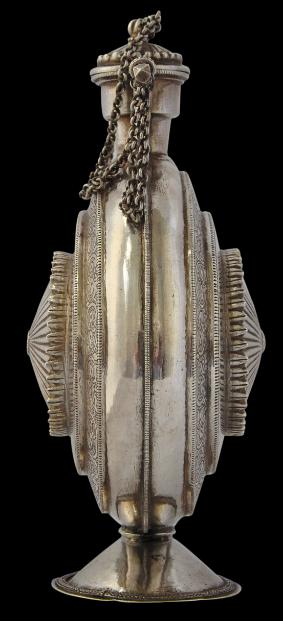
Mughal Silver Flask
Chased Silver Wine or Opium-water Flask
Hyderabad or Deccan, India
19th century
height: 20.5cm, width: 13.5cm, weight: 477g
This flask used either for wine (arak), opium-water which frequently was offered to guests or a sweet coconut beverage known as rhonjkhosura, is of beaten, cast and chased silver. It sits on a wide, flaring conical foot, has a moon-like body engraved to both sides with a floral and vegetal scrolling border and with a central, raised gadrooned or serrated roundel of multiple petal flower form. A tiered neck leads to a petal-form cover. Two narrow tube spouts of spiral form rise from the shoulders of the body. These have small plugs with attached silver chains that in turn are attached to the lid.
The form of this flask mirrors the flattened moon-shaped pilgrim bottles of medieval Europe (See Szilagyi, 2004, p. 82 for an example.) This form was used elsewhere too – most notably in the moon flasks used for beer in Tibet and ceramic moon flasks of the Tang Dynasty in China.
A similar moon-shaped flask but with a single spout is illustrated in Terlinden (1987, p. 119).
Provenance
UK art market.
References
Terlinden, C., Mughal Silver Magnificence, Antalga, 1987; and Szilagyi, A., (ed.), Hungry’s Heritage: Princely Treasures from the Esterhazy Collection, Paul Holberton Publishing, 2004.
Inventory no.: 1066
SOLD





The front and back faces of the flask.

